
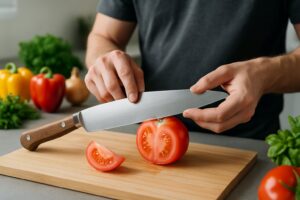

Damascus steel and carbon steel are two of the most common materials used to forge knife blades. They have a lot in common: they are both strong, durable, and have very sharp edges that are easy to cut with. Neither are resistant to stains or rust and must be carefully maintained.
Both kinds of steel are strong and durable, but they have different looks and uses. If you want a simple, functional knife, carbon steel can be a smart pick. If you care about design and want something that stands out, Damascus steel offers unique patterns that catch the eye. Either way, you’ll have a knife that will perform well for a long time to come.
There are actually two types of Damascus steel that may be referred to: historical Damascus steel and modern Damascus steel. Historical Damascus steel was produced in classical times. It seems to have been made in Sri Lanka and India, then sold in the Damascus region of Syria. Damascus swords and knives were known to be very strong and sharp, but the methods used to produce these blades have been lost to time.
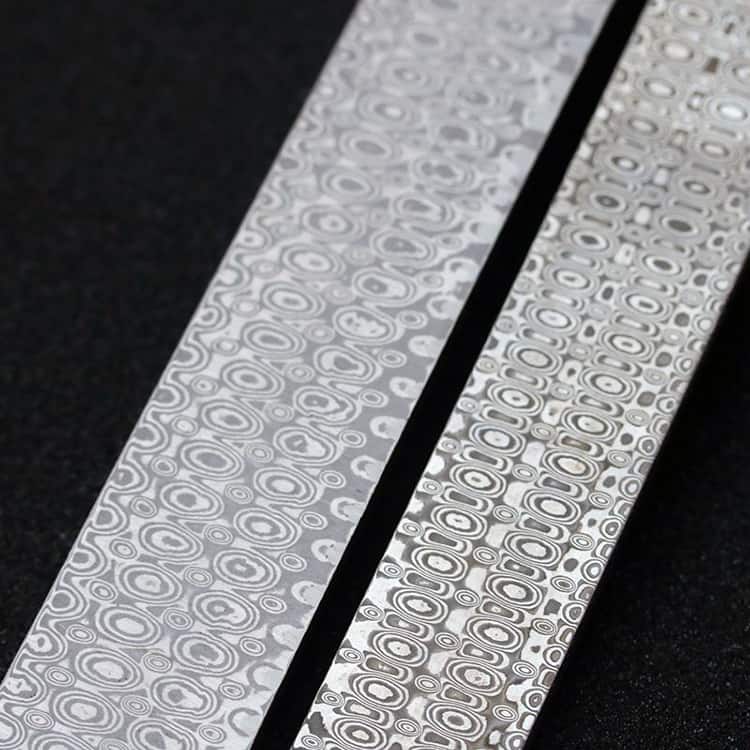
Modern Damascus steel attempts to reproduce the strength, sharpness, and beauty of traditional Damascus blades. There are a few techniques used to accomplish this, but they mostly consist of folding many layers of steel and iron together. This provides impressive strength and causes the blade to display a beautiful swirling pattern.
Damascus blades are usually composed of layers of both hard and soft sheets of steel. The hard steels allow the knife to cut easily, while the soft steels absorb shocks and impacts. Together with the folds of metal formed during forging, this makes the blade very strong.
Historical Damascus blades were known to be very sharp, which is why they were used for swords. Modern Damascus knives have retained this quality. They are incredibly sharp and keep their edge longer than most other knives, so they stay that way.
The strength and sharpness of Damascus knives make them very durable. The ability to absorb shocks and retain a sharp edge for a long time means your new Damascus knife will last for years to come.
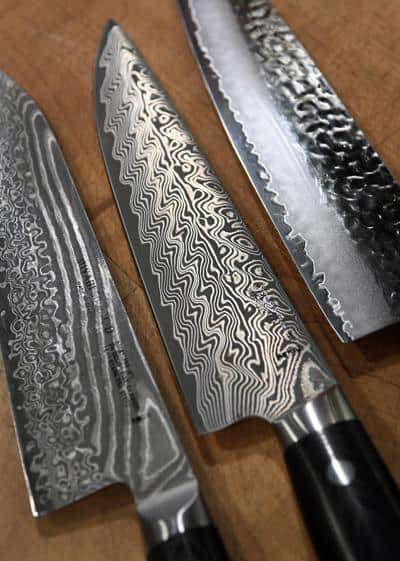
Carbon steel is any steel that contains at least 2.1 percent carbon. Typically, it also contains other alloys, which could vary from one blade to the next. Some alloys, such as copper, manganese, and silicon, are limited in their inclusion, but others don’t have such limits. These other alloys could include chromium, nickel, titanium, cobalt, tungsten, and many others.
Though 2.1 percent is the minimum, carbon levels in any given knife could be much higher. In fact, the higher the percentage of carbon, the harder and stronger the steel becomes, especially when heat is applied.
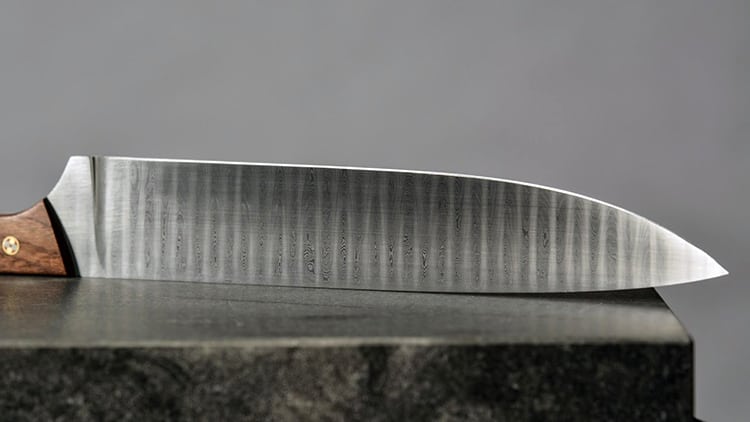
Carbon steel has a modern look to it, which contrasts with the traditional appearance of Damascus steel. This may appeal to those looking for a more practical look in the kitchen or while hunting.
Carbon steel knives cut easily and powerfully. This is because the high carbon content lends hardness to the blade. Different knives will have different levels of hardness, due to varying levels of carbon.
The hardness of carbon steel also makes these knives extremely durable. They are designed to last for a long time, and are considered by some to be nearly indestructible.
Carbon steel knives are very sharp and hold their edge for a long time. Their sharpness rivals that of Damascus knives. They are also very easy to sharpen with standard water stones, sharpening rods, and other tools.

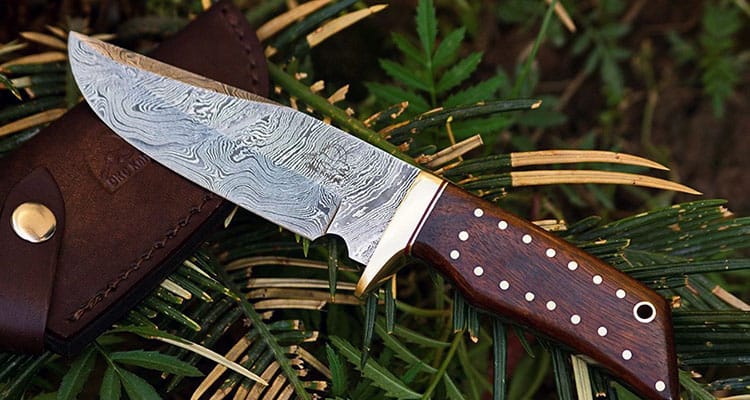
When choosing between carbon steel and Damascus steel, you should focus on how they perform in real use. These blades differ in hardness, edge retention, and how they respond to moisture.
| Steel Type | Hardness | Durability | Flexibility |
|---|---|---|---|
| Carbon Steel | High | Durable | Low – Med |
| Damascus Steel | Med – High | Durable | Medium |
Carbon steel is known for its high hardness levels, especially in knife blades meant for tough jobs. Hardness helps the blade keep a sharp edge but can also make it more brittle if not balanced well. Most professional chef and hunting knives made from carbon steel offer stronger performance during heavy use.
Damascus steel gets its strength from layers of different steels that are forged together. This blend creates a mix of toughness and some flexibility, reducing the chance of chips or cracks under stress. Its hardness can vary depending on the types of steel used and the forging process.
Carbon steel often wins in pure strength, but Damascus can resist impacts better because of its layered build. Both are durable, but each has unique qualities depending on your needs.
Carbon steel blades are popular with chefs and hunters due to their ability to take and keep an extra sharp edge. You can sharpen them to a razor finish, which is important if you need your kitchen or hunting knife to cut cleanly every time.
Damascus steel knives are considered specialty knives. This can make them more expensive than other types of knives. These knives are sharp, but their edge depends on the quality of the base steels used. Good quality Damascus steel can match or even beat some carbon steel blades for edge retention. Lower quality Damascus might need sharpening more often.
With regular sharpening, both types can keep a fine edge. Many users feel carbon steel stays sharp longer in daily use. This is valuable if you want a blade that needs less frequent attention while working.
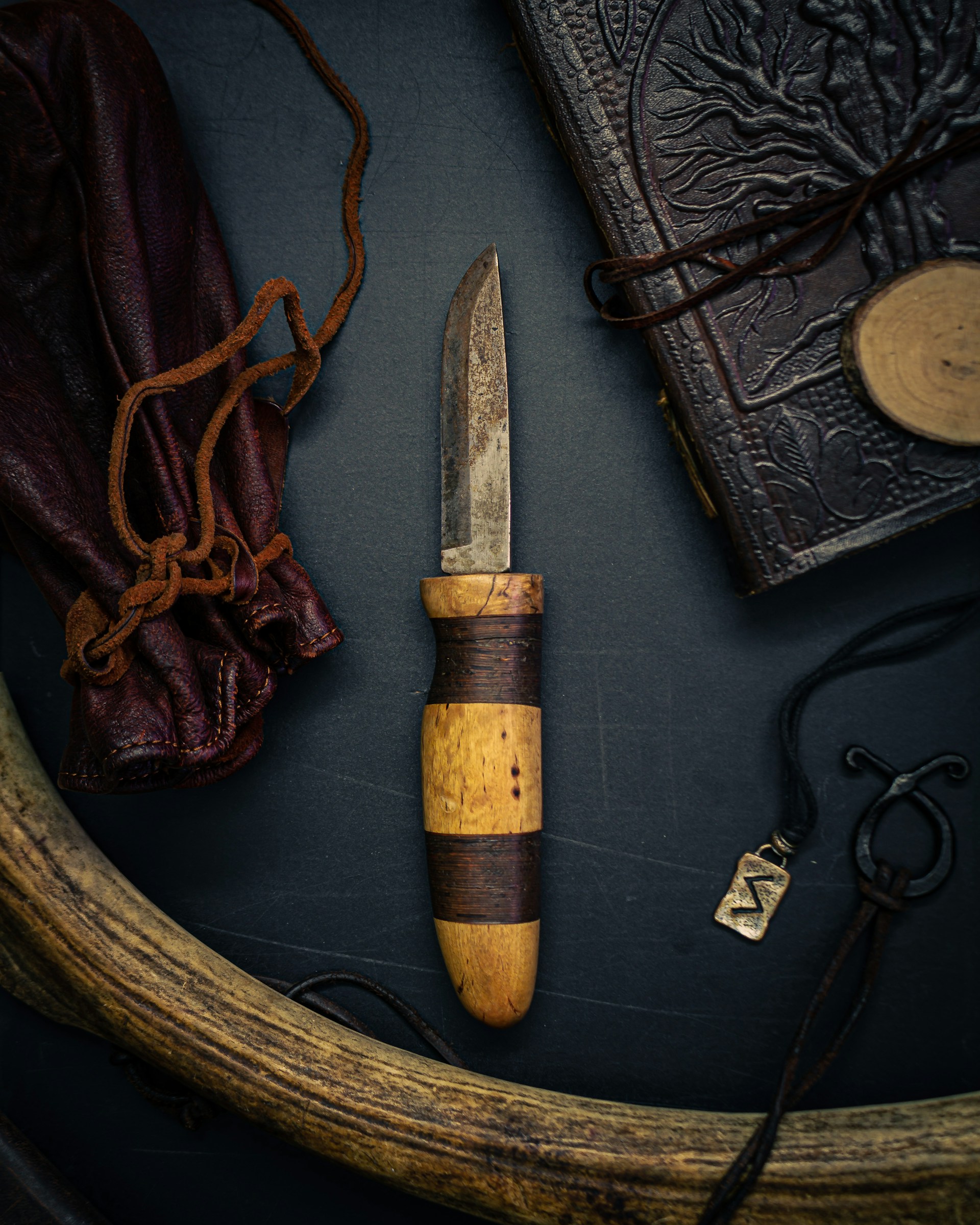
Carbon steel is more likely to rust if you do not care for it properly. You need to dry it right after washing and may need to oil the blade, especially if you use your knife often in damp environments. This higher risk of rust makes maintenance important.
Damascus steel offers some extra corrosion resistance, mainly because its outer layers can sometimes be made of rust-resistant materials. Not all Damascus steel is the same, so you should not assume it will be free from rust.
If you want a blade that will need less care, look for Damascus steel that uses stainless steel layers. Both types require some maintenance to stay in good shape over time.
Damascus steel knives are usually more expensive. Their unique patterns and older forging methods make them valuable for collectors. Many people buy Damascus blades as display pieces or investments, not just for practical use. Rare patterns, handmade work, and brand reputation can all raise the price.
Carbon steel knives are typically more affordable. They hold value if they are made by skilled makers or are part of a famous series, but they don’t reach the same collectibility as Damascus blades. Knife collectors often pick up carbon steel for everyday use and practical reasons due to their lower cost.
Damascus steel stands out if you want a blade for its rare looks, artistry, or collection value. For those focused on use and affordability, carbon steel may better suit your needs.
Picking between carbon steel and Damascus steel depends on what you want from your blade. You should think about how you’ll use your knife, what features matter most to you, and how much care you’re willing to give.
Carbon steel knives are popular in the kitchen and with outdoor enthusiasts. They keep a sharp edge for a long time, which helps with precise cutting. These knives are a good choice for tasks like chopping vegetables, slicing meat, and detailed work.
Damascus steel is known for its unique wavy patterns and good performance. It is often picked for its eye-catching look, making it a favorite among collectors.
Damascus steel can be used for both cooking and hunting knives. The steel balances sharpness and beauty, so you get both function and style.
Choosing between Damascus steel and high carbon steel knives depends on sharpness, edge retention, durability, ease of care, and appearance. Each option has strengths and weaknesses that may suit your habits and cooking style.
Damascus Steel Pros
Damascus Steel Cons
Carbon Steel Pros
Carbon Steel Cons
Damascus steel blades show attractive wavy patterns and offer a good blend of strength and flexibility. Many cooks find they hold a sharp edge well but are not as hard as some high carbon steels.
High carbon steel blades are usually harder and can stay sharper longer with proper care. They work well for heavy tasks and can sometimes resist chipping better. You may notice better edge retention with high carbon steel, especially for harder uses.
Both Damascus and high carbon steel knives can rust or stain if not dried or oiled after use. Carbon steel often needs more attention because it can develop rust spots quickly if left wet.
Many Damascus blades have a carbon steel core, so they need similar care. Keeping both types clean and dry helps prevent rust. Regularly oiling the blade is a good practice for both materials.
For the hardest and sharpest edge, professionals usually prefer high carbon steel for precise cuts and long-lasting sharpness. It handles heavy and repeated use well.
Damascus blades also provide a sharp edge and can be very durable because they combine layers of tough and flexible metals. However, their edge may not last as long under constant pressure from hard materials. For tasks like slicing, Damascus is an excellent choice, but for heavy-duty cutting, carbon steel is often favored.
Damascus blades can be strong, especially when makers use quality materials and forging techniques. However, traditional Katanas made from high carbon steel are often harder and tougher, designed for hard use in martial arts.
Most modern Damascus knives are not made for the same power as a Katana blade. If you need a blade for heavy cutting or martial arts practice, high carbon steel is usually the standard choice.
Both steel types can rust, especially if they contain a lot of carbon. Some modern Damascus blades use stainless steel layers to help resist rust, but many traditional Damascus and most high carbon knives will react to moisture.
If you want a blade that resists stains, choose stainless or stainless-clad options. Otherwise, keep both steel types clean and dry to avoid rust.
Damascus steel stands out because of its unique swirl or wave-like patterns on the blade. Blacksmiths create these patterns by folding and forging layers of different metals. Many people find this look more beautiful, and each knife has a unique appearance.
High carbon steel has a simpler appearance. It usually looks uniform and does not have detailed patterns. Some people like this clean, plain style, while others prefer the visual flair of Damascus steel patterns.
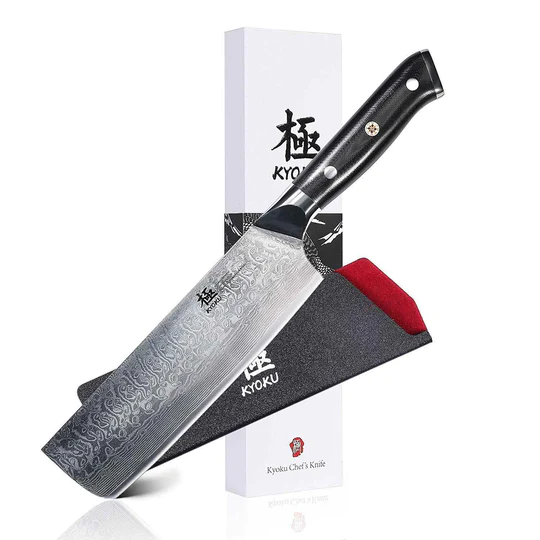
Knife Buzz offers independent product reviews on a wide range of knives used in the kitchen, home, and outdoors. We make it easy for you to find the right knife at the best price.